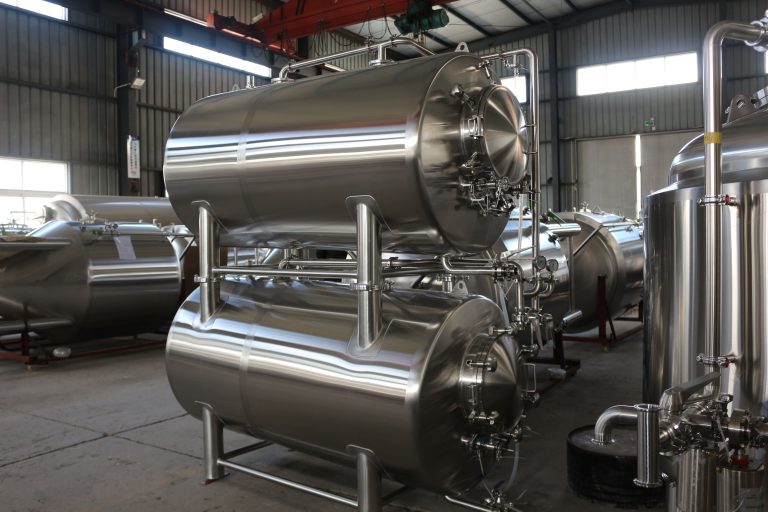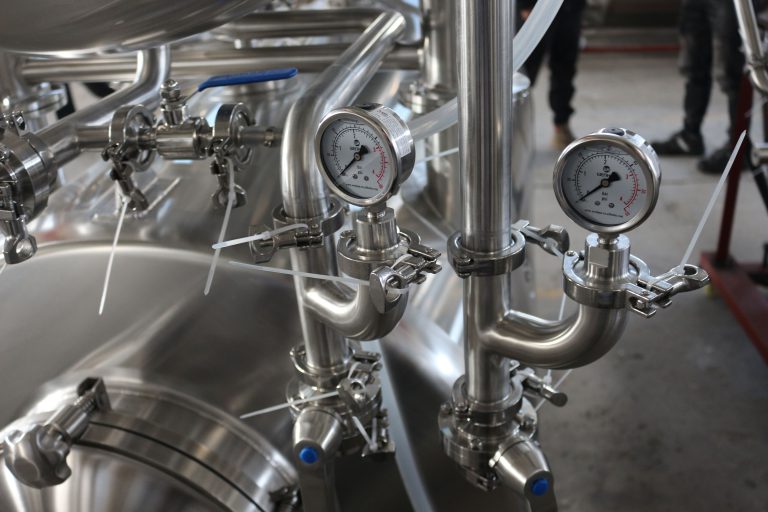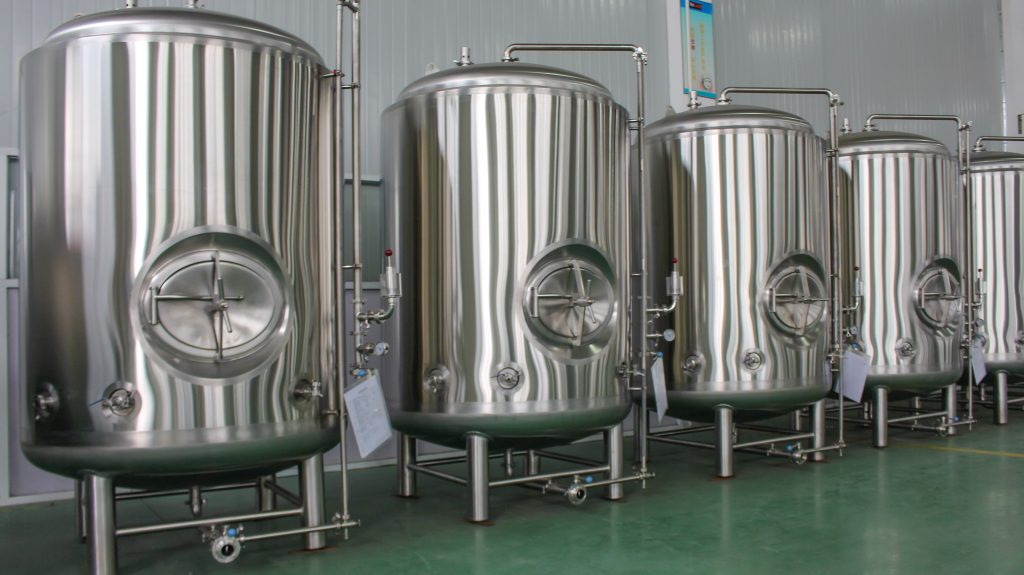Invoering

Brewery tanks are the heart of any brewing operation, whether a small craft brewery or a large-scale industrial facility. These vessels are where the magic of transforming simple ingredients like water, malt, hops, and yeast into delicious beer happens. Among the various materials used for constructing brewery tanks, stainless steel has emerged as the industry standard due to its numerous advantages. This comprehensive guide delves into the benefits of stainless steel brewery tanks, exploring their impact on beer quality, operational efficiency, and long-term cost-effectiveness. We’ll examine different types of brewery tanks, their specific functions, and address frequently asked questions to provide a complete understanding of this essential brewing equipment.
Why Stainless Steel is the Preferred Material for Brewery Tanks
Stainless steel offers a unique combination of properties that make it ideal for brewery tank construction.
- Corrosiebestendigheid: This is perhaps the most crucial benefit. The high chromium content in stainless steel forms a passive chromium oxide layer on the surface, protecting it from rust and corrosion caused by the acidic nature of wort and beer, as well as cleaning chemicals. This resistance ensures the longevity of the tanks and prevents contamination of the beer.
- Hygienic Properties: Stainless steel’s smooth, non-porous surface inhibits the growth of bacteria and other microorganisms. This is critical in maintaining sanitary conditions within the brewery and preventing unwanted flavors or spoilage in the beer. Cleaning and sanitizing stainless steel brewery tanks is also much easier compared to other materials.
- Duurzaamheid en levensduur: Stainless steel is incredibly strong and durable, capable of withstanding the rigors of daily brewery operations, including temperature fluctuations, pressure changes, and frequent cleaning cycles. Properly maintained stainless steel brewery tanks can last for decades, offering a significant return on investment.
- Temperatuurregeling: Stainless steel’s excellent thermal conductivity allows for efficient heat transfer, which is essential for precise temperature control during various stages of brewing, including mashing, boiling, fermentation, and conditioning. This precise control is crucial for achieving consistent beer quality.
- Ease of Cleaning and Maintenance: The smooth surface of stainless steel makes it easy to clean and sanitize, reducing downtime and labor costs. Regular cleaning prevents the buildup of beer residue and biofilms, ensuring optimal hygiene and preventing off-flavors.
- Neutral Flavor Profile: Unlike some other materials, stainless steel does not impart any flavors or odors to the beer. This ensures that the beer’s intended flavor profile is preserved throughout the brewing process.
- Aesthetic Appeal: Stainless steel brewery tanks have a clean, modern, and professional appearance, contributing to the overall aesthetics of the brewery.
Types van Brewery Tanks and Their Functions
A modern brewery typically utilizes a variety of stainless steel tanks, each designed for a specific purpose:
- Mash Tuns: These tanks are used for mashing, the process of converting starches in malted grains into fermentable sugars. Mash tuns are often equipped with rakes or stirrers to ensure even mixing and temperature distribution.
- Lauter Tuns: Following mashing, the wort (sugar-rich liquid) is separated from the spent grain in the lauter tun. These tanks have a false bottom with fine slits to filter the wort.
- Brouwketels: In the brew kettle, the wort is boiled with hops to extract bitterness, aroma, and flavor compounds. The boiling process also sterilizes the wort and removes unwanted volatile compounds.
- Whirlpool Tanks: After boiling, the wort is transferred to the whirlpool tank, where centrifugal force separates hop debris and other solids from the wort.
- Fermentation Vessels (FV): These are perhaps the most crucial brewery tanks, where the wort is fermented by yeast, converting sugars into alcohol and carbon dioxide. Fermentation vessels come in various shapes and sizes, including cylindrical conical tanks (CCTs) which are very common.
- Conditioning Tanks (Bright Beer Tanks/Brite Tanks): After primary fermentation, the beer is transferred to conditioning tanks for maturation and carbonation. These tanks are often equipped with cooling jackets to maintain precise temperatures.
- Eenheidstanks: These are versatile tanks that can be used for both fermentation and conditioning, offering flexibility for smaller breweries.
The Importance of Proper Brewery Tank Sizing
Choosing the right size of brewery tanks is crucial for efficient brewing operations. Factors to consider include:
- Brewery Capacity: The size of the tanks should be proportional to the desired annual beer production.
- Batch Size: The tank volume should accommodate the planned batch size with adequate headspace for foam and CO2 production during fermentation.
- Brewing Frequency: The number of tanks needed will depend on how often the brewery plans to brew.
- Beschikbaarheid van ruimte: The physical dimensions of the tanks must fit within the available brewery space.
Cleaning and Maintenance of Stainless Steel Brewery Tanks
Proper cleaning and maintenance are essential for ensuring the longevity and performance of stainless steel brewery tanks.
- Clean-in-Place (CIP)-systemen: CIP systems automate the cleaning process, circulating cleaning solutions through the tanks without requiring manual entry.
- Manual Cleaning: In some cases, manual cleaning may be necessary, especially for smaller breweries. This involves using brushes, scrubbers, and appropriate cleaning chemicals.
- Regelmatige inspecties: Regularly inspecting the tanks for any signs of damage or corrosion is crucial for preventing costly repairs.
Benefits of Investing in High-Quality Brewery Tanks
While the initial investment in high-quality stainless steel brewery tanks may be higher, the long-term benefits far outweigh the costs:
- Improved Beer Quality: Consistent temperature control and hygienic conditions lead to better and more consistent beer.
- Verhoogde efficiëntie: Durable and well-designed tanks streamline brewing operations and reduce downtime.
- Reduced Maintenance Costs: High-quality tanks require less maintenance and are less prone to damage.
- Enhanced Brewery Reputation: Investing in professional equipment enhances the brewery’s reputation and attracts customers.
- Increased Resale Value: High-quality brewery tanks hold their value well, making them a good investment.
Brouwerij Tank Specifications Comparison

This table illustrates some key specifications one might consider when choosing brewery tanks. It is important to note that these are general examples, and specific requirements will vary from brewery to brewery. This table does not include brands as requested.
| Functie | Fermentation Vessel (FV) | Brite Tank (BBT) | Brouwketel |
|---|---|---|---|
| Materiaal | 304 Stainless Steel (interior), 304/201 (exterior) | 304 roestvrij staal | 304 roestvrij staal |
| Drukclassificatie | 15 PSI (typically) | 15 PSI (typically) | Atmospheric |
| Koeling | Glycol Jacket | Glycol Jacket | None (direct fire or steam heating) |
| Isolatie | Polyurethane Foam | Polyurethane Foam | Optioneel |
| Interior Finish | 2B or #4 polish (Ra < 0.8µm is common, better is possible) | 2B or #4 polish (Ra < 0.8µm is common, better is possible) | 2B or Mill Finish |
| CIP Spray Ball | Ja | Ja | Ja |
| Sample Valve | Ja | Ja | Ja |
Conclusie
Investing in high-quality stainless steel brouwerij tanks is a strategic decision that can significantly impact the success of any brewery. These tanks are not just containers; they are essential tools that enable brewers to craft exceptional beer consistently and efficiently. By understanding the various aspects of brewery tank technology and making informed choices, breweries can ensure long-term growth and success in the competitive craft brewing industry. From small-scale microbreweries to large production facilities, the principles of quality, hygiene, and efficient design remain paramount in the selection and utilization of brewery tanks. The future of brewing lies in innovation and precision, and the right brewery tanks are the foundation upon which that future is built.
FAQ
Q: How long do stainless steel brouwerij tanks last?
A: With proper care and maintenance, they can last for several decades, often 20-50 years or more.
Q: What is the difference between a fermentation vessel and a brite tank?
A: Fermentation vessels are used for primary fermentation, while brite tanks are used for conditioning and carbonation after fermentation.
Q: Why is stainless steel preferred over other materials for brouwerij tanks?
A: Stainless steel offers superior corrosion resistance, hygienic properties, durability, and temperature control, making it ideal for brewing.

